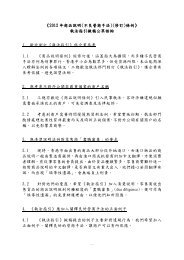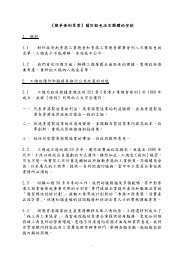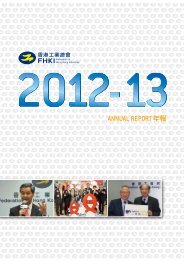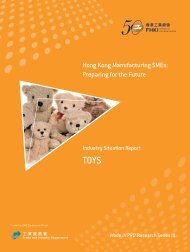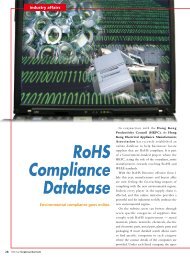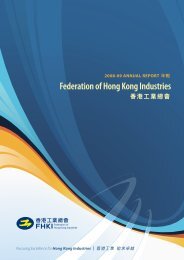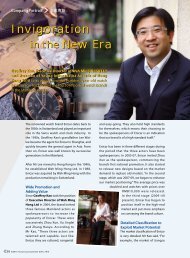Hong Kong Manufacturing SMEs: Preparing for the Future
Hong Kong Manufacturing SMEs: Preparing for the Future
Hong Kong Manufacturing SMEs: Preparing for the Future
- No tags were found...
You also want an ePaper? Increase the reach of your titles
YUMPU automatically turns print PDFs into web optimized ePapers that Google loves.
98Cost Reduction StrategiesStrategies to deal directly with cost increases caninclude <strong>the</strong> following:• Improve efficiency within <strong>the</strong> factoriesImproving efficiency within <strong>the</strong> factories couldinvolve improving factory layouts, optimisingprocess flows, providing additional training <strong>for</strong>workers, and improving management practices.Many <strong>SMEs</strong> could work to install modern cellularand team production processes, reduce <strong>the</strong>physical footprint of activities, debottleneckprocess flows, and more sharply define worktasks <strong>for</strong> greater efficiency.• Automate production processesAutomating production processes is a way toreduce <strong>the</strong> overall labour content, reducingexposure to labour shortages and increasingwage rates. This can only be done if <strong>the</strong>processes can effectively be automated and if<strong>the</strong> capital required is not beyond <strong>the</strong> means of<strong>the</strong> <strong>SMEs</strong>. As labour becomes more expensiveand scarce, companies should identify laboursaving automation that would not have madesense in China in <strong>the</strong> past. This could includenot only automation of individual manufacturingoperations, but of materials handling andpackaging as well.• Improve efficiency in logistics, distributionand o<strong>the</strong>r activitiesImproving efficiency in logistics, distribution,and o<strong>the</strong>r activities can often reduce total costsmore than improvements in manufacturing.A comprehensive approach to cost reductionprovides <strong>the</strong> best opportunity to offset costincreases. Logistics and distribution costs are oftenhigher than actual production costs. <strong>SMEs</strong> shouldundertake an examination of <strong>the</strong>ir total costpicture, identify key cost elements (not just in <strong>the</strong>actual manufacturing), and develop cost controlstrategies in response.• Outsource business processes<strong>SMEs</strong> often face inefficiencies in businessprocesses, such as accounting, payroll, in<strong>for</strong>mationtechnology, warehousing, and o<strong>the</strong>rs due to a lackof scale and specialised resources. Outsourcingsuch business processes can often lower <strong>the</strong> costs<strong>for</strong> <strong>SMEs</strong>. In some cases, such services can bepurchased in bulk by groups of firms coordinatedby industry associations.• Relocate to o<strong>the</strong>r places in ChinaAs costs rise in <strong>the</strong> Pearl River Delta, manufacturing<strong>SMEs</strong> have <strong>the</strong> option to relocate production too<strong>the</strong>r parts of China in which costs are lower. Thiscan only be done effectively if <strong>the</strong> relevant supplychains can be extended to <strong>the</strong> new locations andif <strong>the</strong> <strong>Hong</strong> <strong>Kong</strong> firms can manage far<strong>the</strong>r afieldthan <strong>the</strong> PRD. <strong>SMEs</strong> should investigate wheresupply chains might support new productionlocations and should follow <strong>the</strong> moves of largecompanies that could bring <strong>the</strong>ir suppliers with<strong>the</strong>m if <strong>the</strong>y relocate.• Relocate to o<strong>the</strong>r places in South orSou<strong>the</strong>ast AsiaRelocating to o<strong>the</strong>r countries, mostly probably inSouth or Sou<strong>the</strong>ast Asia can be ano<strong>the</strong>r optionto combat rising costs in China. However, thiswill only be feasible if <strong>the</strong> infrastructure, supplychains, labour <strong>for</strong>ce, and regulatory environmentare suitable. Again, this also requires <strong>the</strong> <strong>Hong</strong><strong>Kong</strong> firms to manage in a new environment thatmight not be as accessible as <strong>the</strong> PRD.• Relocate along with similar firmsMuch of <strong>the</strong> discussion of potential relocationof <strong>Hong</strong> <strong>Kong</strong> companies assumes that <strong>the</strong>ymove as individual firms. In some industries,it might prove beneficial <strong>for</strong> groups of firmsto move simultaneously in order to ensurea critical mass exists in <strong>the</strong> new location toattract suitable suppliers. There are examplesof such group relocation in <strong>the</strong> Italian footwearindustry and in mobile handsets, where agroup of firms moved from Shenzhen toHuizhou with <strong>the</strong> support of <strong>the</strong> Huizhou and




